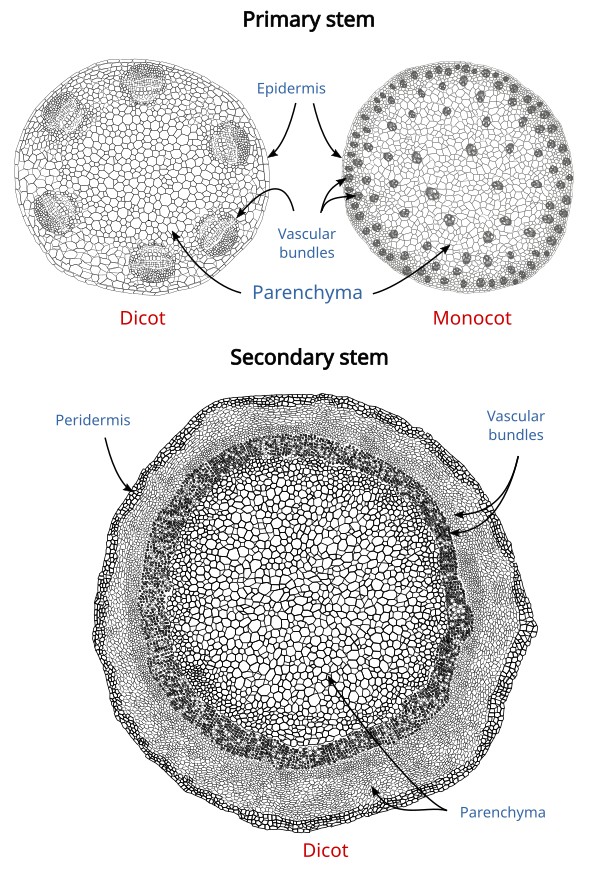The stem is the aerial part of the plant that supports other aerial organs like leaves, flowers, fruits, and seeds. Other functions of the stem are conducting substances, photosynthesis, and storing. The final morphology of the stem (height, width, robustness, branching pattern) depends on the interaction between genetic information and the environment.
In the embryo, the stem is known as the plumule, which consists of an axis and a caulinar meristem protected by undifferentiated leaves, known as primordial leaves, at the tip. After germination, the caulinar apical meristem is responsible for the increase in length of the stem, forming nodes and internodes. Nodes are the places where the leaves and lateral branches are inserted (Figure 1). The axillary buds are composed of a group of cells that form a meristem and several primordial leaves protecting the meristem. Axillary buds are found at the insertion point of leaves in the nodes and give rise to lateral branches and flowers. Internodes are the stem regions between nodes. They lack lateral organs. It can be said that the stem is made up of nodes, internodes, and axillary buds tidily arranged. A phytomer consists of a node, an internode region, and the axillary bud that is repeated along the stem. This modular design facilitates the construction of shoots and plant adaptation to the environment.

TTwo types of growth happen in the stem: primary and secondary (Figure 2). Primary growth is found during the early growth of every stem, when the stem tissues are directly differentiated from the shoot (caulinar) apical meristem. This meristem is more complex than the root apical meristem because it gives rise to all stem tissues, leaf primordia, and axillary buds of the nodes. It means that it is responsible for all the lateral organs of the stem. The shoot apical meristem does not show any protective covering. The intercalary meristem is derived from the shoot apical meristem. It is first found in the internode region and later at the base, close to the node. Most of the growth in length of the stem is derived from the activity of the intercalary meristem. Most dicot and gymnosperm plants show secondary growth, which increases the diameter of the stem. This growth is produced by the activity of secondary meristems: vascular cambium and cork cambium. In monocot plants, the secondary growth is supposed to be lost during evolution because the procambium is differentiated in vascular tissue instead of remaining as undifferentiated tissue. However, some monocot plants have developed a lateral meristem known as the peripheral growing meristem, or monocot cambium, which produces vascular bundles with the phloem wrapped by the xylem.

The branches of the stem emerge from the axillary buds. As mentioned above, the axillary buds develop from the apical cualinar meristem. Branches are not formed from those axillary buds close to the caulinar apical meristem because the meristem inhibits the activation of those axillary buds. This inhibition is known as apical dominance. As the stem grows in length, the caulinar apical meristem separates from the already-formed axillary buds, and the apical dominance gets attenuated, inducing the axillary buds to develop into branches. There are plants without lateral branches, like palms.
In some plant species, there are specialized structures in the stem, such as tendrils of ivy and vine, with a supporting role. There are also thorns in rose stems for protection (thorns are not modified leaves) and cladodes of asparagus trees that work as leaves, but they are not.
The stems of some species do not emerge above the ground, and only the leaves are aerial. These stems are known as rhizomes. In some species, the stem is a sophisticated storage organ. For example, potatoes have underground stems specialized in storing starch, which is what we eat. Most of a potato is actually a storage parenchyma under the epidermis. The potato "eyes" are the axillary buds. These stems are known as tubercles. Some xerophytes have stems specialized for storing water. The stems of prickly pears (cactus) look like large and thick leaves, but actually the leaves are the spines.